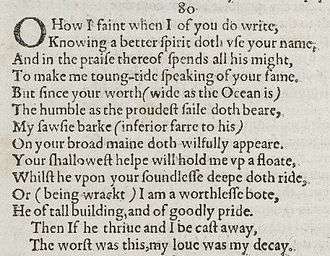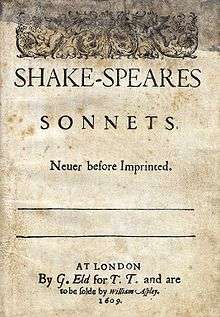Sonnet 80
| Sonnet 80 | |||||||
|---|---|---|---|---|---|---|---|
 Sonnet 80 in the 1609 Quarto | |||||||
|
| |||||||
| |||||||
Sonnet 80 is one of 154 sonnets written by the English playwright and poet William Shakespeare. It is a member of the Fair Youth sequence, in which the poet expresses his love towards a young man, and the third sonnet of the Rival Poet subsequence.
Synopsis
Knowing that a better poet is praising the youth, the poet feels inadequate. However, since the youth's value is as big as the ocean there is room for both poets to sail the ships of their verse on it: the impressive galleon of the rival poet and the small vessel of the speaker.
Structure
Sonnet 80 is an English or Shakespearean sonnet. The English sonnet has three quatrains, followed by a final rhyming couplet. It follows the typical rhyme scheme of the form, abab cdcd efef gg and is composed in iambic pentameter, a type of poetic metre based on five pairs of metrically weak/strong syllabic positions. The 10th line exemplifies a regular iambic pentameter:
× / × / × / × / × / Whilst he upon your soundless deep doth ride; (80.10)
- / = ictus, a metrically strong syllabic position. × = nonictus.
The meter demands a few variant pronunciations: the 2nd line's "spirit" functions as 1 syllable (possibly pronounced as spear't, sprite, sprit, or spurt[2]), the 7th line's "inferior" as 3 syllables, and the 9th line's "shallowest" as 2.[3]
The sonnet exhibits some common metrical variations, for example, an initial reversal in the 2nd line:
/ × × / × / × / × / Knowing a better spirit doth use your name, (80.2)
Reversals can also occur mid-line, as occurs in line 5; and some may be optional, as the possible initial reversals in lines 1 and 13. Also possible is the rightward movement of the first ictus (the resulting four-position figure, × × / /, is sometimes referred to as a minor ionic):
× × / / × / × / × / On your broad main doth wilfully appear. (80.8)
Notes
- ↑ Pooler, C[harles] Knox, ed. (1918). The Works of Shakespeare: Sonnets. The Arden Shakespeare [1st series]. London: Methuen & Company. OCLC 4770201.
- ↑ Booth 2000, p. 262.
- ↑ Booth 2000, p. 274.
References
- First edition and facsimile
- Shakespeare, William (1609). Shake-speares Sonnets: Never Before Imprinted. London: Thomas Thorpe.
- Lee, Sidney, ed. (1905). Shakespeares Sonnets: Being a reproduction in facsimile of the first edition. Oxford: Clarendon Press. OCLC 458829162.
- Variorum editions
- Alden, Raymond Macdonald, ed. (1916). The Sonnets of Shakespeare. Boston: Houghton Mifflin Company. OCLC 234756.
- Rollins, Hyder Edward, ed. (1944). A New Variorum Edition of Shakespeare: The Sonnets [2 Volumes]. Philadelphia: J. B. Lippincott & Co. OCLC 6028485.
- Modern critical editions
- Atkins, Carl D., ed. (2007). Shakespeare's Sonnets: With Three Hundred Years of Commentary. Madison: Fairleigh Dickinson University Press. ISBN 978-0-8386-4163-7. OCLC 86090499.
- Booth, Stephen, ed. (2000) [1st ed. 1977]. Shakespeare's Sonnets (Rev. ed.). New Haven: Yale Nota Bene. ISBN 0-300-01959-9. OCLC 2968040.
- Burrow, Colin, ed. (2002). The Complete Sonnets and Poems. The Oxford Shakespeare. Oxford: Oxford University Press. ISBN 978-0192819338. OCLC 48532938.
- Duncan-Jones, Katherine, ed. (2010) [1st ed. 1997]. Shakespeare's Sonnets. The Arden Shakespeare, Third Series (Rev. ed.). London: Bloomsbury. ISBN 978-1-4080-1797-5. OCLC 755065951.
- Evans, G. Blakemore, ed. (1996). The Sonnets. The New Cambridge Shakespeare. Cambridge: Cambridge University Press. ISBN 978-0521294034. OCLC 32272082.
- Kerrigan, John, ed. (1995) [1st ed. 1986]. The Sonnets ; and, A Lover's Complaint. New Penguin Shakespeare (Rev. ed.). Penguin Books. ISBN 0-14-070732-8. OCLC 15018446.
- Mowat, Barbara A.; Werstine, Paul, eds. (2006). Shakespeare's Sonnets & Poems. Folger Shakespeare Library. New York: Washington Square Press. ISBN 978-0743273282. OCLC 64594469.
- Orgel, Stephen, ed. (2001). The Sonnets. The Pelican Shakespeare (Rev. ed.). New York: Penguin Books. ISBN 978-0140714531. OCLC 46683809.
- Vendler, Helen, ed. (1997). The Art of Shakespeare's Sonnets. Cambridge, MA: The Belknap Press of Harvard University Press. ISBN 0-674-63712-7. OCLC 36806589.
.png)
